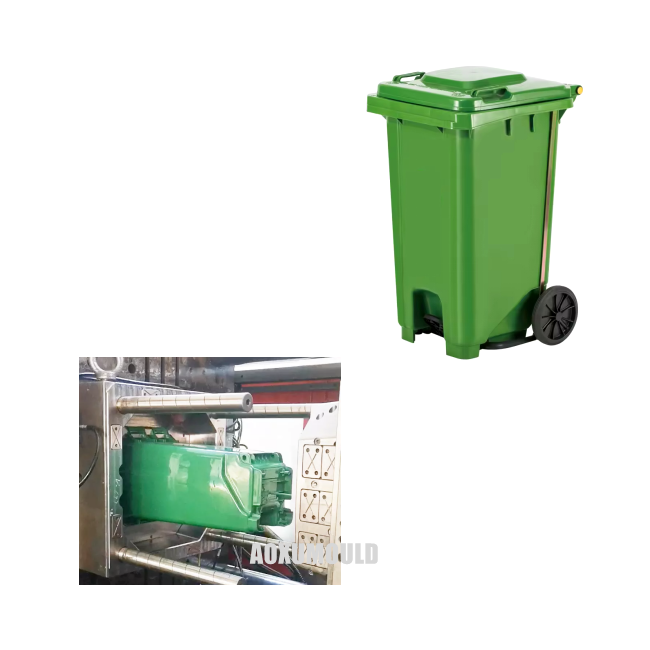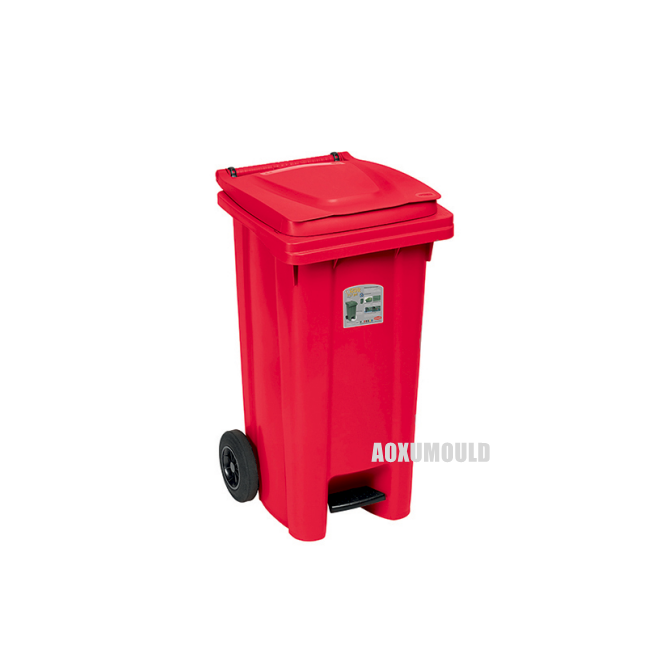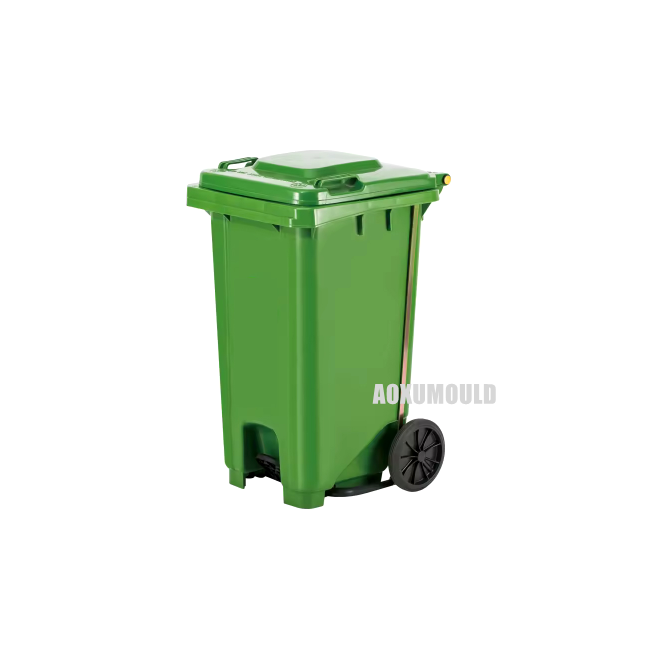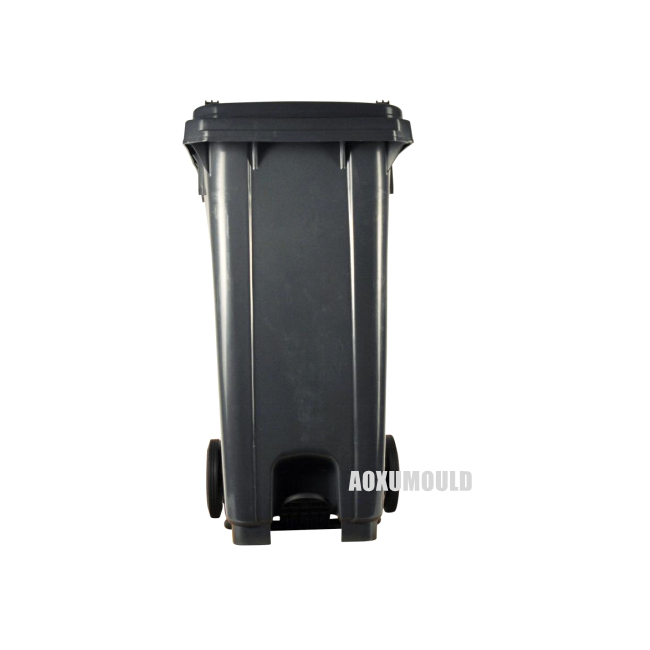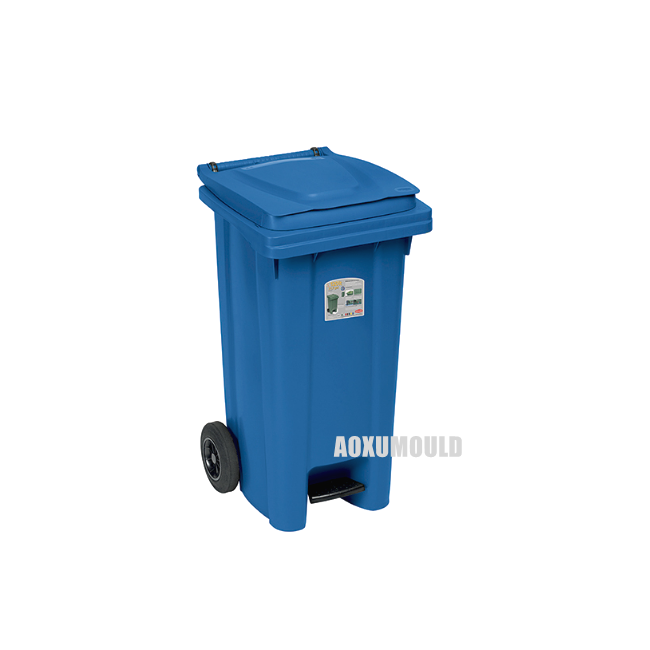Mould Specifications
|
Mould name |
Plastic 360L Bin Mould |
|
Product material |
HDPE, plastic |
|
Product Size |
878x596x1098mm |
|
Product capacity |
360 liters |
|
Mould material for cavity &. Core |
P20, 718, 2738 |
|
NOs of cavity |
1 cavity |
|
Injection system |
Hot runner open gates/valve gates |
|
Suitable injection machine |
3300T |
|
Mould size |
1580X1250X1500mm |
| Mould weight |
23500T |
|
Mould lifetime |
more than 300,000pcs |
|
T1 Time |
After design is finalized, 55 days |
The Typical Dimensions For A 360L Plastic Bin:

The 360L(approximately 95 US gallon) plastic wheeled trash bin is a standard workhorse for commercial and municipal waste collection, designed for durability and efficient handling. Its dimensions are optimized for capacity, stability, mechanical lifting, and manual maneuverability.
1.Overall Height: Typically ranges from 1070 mm to 1120 mm (42.1 to 44.1 inches). This height allows for easy access when depositing waste while maintaining a low center of gravity for stability when full. The lid adds approximately 100-120 mm (4-5 inches) to the height when fully open.
2.Main Body Diameter (Top): The external diameter at the widest point, usually just below the rim, is commonly 585 mm to 615 mm (23.0 to 24.2 inches). This dimension is critical for compatibility with automated lifters on collection vehicles, which require standardized widths to grip the bin securely.
3.Main Body Diameter (Base): The base is significantly narrower to enhance stability and facilitate nesting during storage or transport. External diameters at the base typically measure 480 mm to 510 mm (18.9 to 20.1 inches). This tapering profile also aids in the injection molding ejection process.
4.Wheelbase Width: The distance between the centers of the two large wheels is crucial for stability and rolling. This generally falls within 490 mm to 520 mm (19.3 to 20.5 inches). The wheels themselves are typically large, around 200 mm to 250 mm (8 to 10 inches) in diameter, to handle rough terrain and heavy loads.
4.Overall Length (with Wheels & Handle): The total length, measured from the front of the bin body to the back of the extended handle, is typically 710 mm to 760 mm (28.0 to 29.9 inches). The handle itself protrudes backwards by about 150-200 mm (6-8 inches) from the bin's rear wall.
4.Wall Thickness: Injection molding allows for precise and consistent wall thickness. Main body walls are typically 3.5 mm to 5.0 mm thick. Critical stress areas like the wheel axle housings, handle attachment points, and the rim/lid interface are often reinforced with ribs or locally increased thickness (up to 6-8 mm) for enhanced structural integrity.
4.Rim Structure: The top rim is robust and flanged externally to provide a secure sealing surface for the lid and a strong grip point for lifters. Its external width (lip) is usually 15 mm to 25 mm (0.6 to 1.0 inch). The internal rim diameter (actual opening for waste) is approximately 540 mm to 570 mm (21.3 to 22.4 inches).
5.Lid Dimensions: The hinged lid closely matches the top body diameter. Its diameter is slightly larger than the body's top diameter to overlap, typically 600 mm to 630 mm (23.6 to 24.8 inches). Lid thickness is similar to the body, around 4-5 mm, often with reinforcing ribs underneath.
6.Footprint (Base): The rectangular base footprint, defined by the bottom edges and wheel positions, is usually 520 mm x 580 mm to 550 mm x 610 mm (20.5 x 22.8 in to 21.7 x 24.0 in). Feet or runners elevate the base slightly off the ground.
7.Stacking/Nesting Height: When nested inside an identical empty bin for storage/transport, the top rim sits significantly lower. The visible height when nested is typically 700 mm to 750 mm (27.6 to 29.5 inches), achieved through the tapered body design.
8.Draft Angles: Critical for mold release, subtle draft angles (0.5° - 2°) are incorporated into all vertical surfaces, slightly contributing to the taper from top to bottom.
9.Tolerances: Dimensional tolerances for mass-produced injection-molded bins are typically in the range of ± 2mm to ± 5mm (±0.08 to ±0.2 inches) for critical features like diameters and heights.
These dimensions represent common industry standards for a 360L injection-molded wheeled bin, ensuring functionality, compatibility with collection systems, structural strength, and efficient manufacturing. Exact measurements can vary slightly between manufacturers based on specific mold design and reinforcement strategies.
Structural Features of A 360L Bin Mould

1.Thin wall: To save materials and costs, the wall thickness of the barrel is usually designed to be relatively thin (e.g. 3-5mm). This imposes high requirements on the cooling system of the mold and the injection molding process control (such as holding pressure and preventing shrinkage).
2.Deep cavity: The barrel is very deep. The ejection angle must be sufficient (usually above 2-3 degrees) otherwise ejection will be difficult and the product is prone to being scratched. The design of the ejection system is of crucial importance.
3.Reinforcement ribs: To enhance rigidity and resistance to deformation, dense reinforcement ribs are usually designed on the bottom of the barrel and the sides of the barrel body. This increases the difficulty of mold processing (especially polishing) and the complexity of demolding.
4.Bucket opening and bucket edge: It is necessary to ensure strength and flatness, and a slider core structure may be involved.
5.Bottom structure: There may be anti-slip patterns, drainage holes, wheel mounting holes, etc. Corresponding mold structures (such as inserts, spacers, sliders) are required.
Bucket lid fit: If the bucket lid is included (usually produced separately), the design of the bucket opening needs to take into account the fit accuracy with the lid.
What Kind of Plastic is Used To Make A 360L Bin?

360L Bin Produced with HDPE Material
The 360L bin is manufactured using high-density polyethylene (HDPE) through injection molding processes. This material ensures exceptional durability, impact resistance, and long-term performance in both indoor and outdoor environments.
1. Material:
- HDPE (High-Density Polyethylene)
- UV-stabilized to prevent degradation from sunlight exposure.
- Resistant to chemicals, corrosion, and extreme temperatures (-30°C to 60°C).
2. Design Specifications:
- Capacity: 360 liters (95 gallons)
- Standard color options: Green, Black, Blue, or custom Pantone colors.
- Reinforced base and walls for structural integrity.
- Ergonomic handles and smooth edges for safe handling.
3. Functional Advantages:
- Weatherproof &. Waterproof: Suitable for outdoor use (e.g., parks, streets).
- Easy Cleaning: Non-porous surface prevents staining and bacterial growth.
- Stackable Design (for empty bins) to save storage/transport space.
4. Compliance & Certifications:
- Meets EU standards (EN 840) for mobile waste containers.
- Recyclable material (100% HDPE) aligns with environmental regulations.
5. Optional Accessories:
- Lockable lids (to prevent unauthorized access).
- Wheels (2 or 4 units) for mobility.
- Foot pedal mechanism (hands-free operation).
Injection Molding Process for A 360L Plastic Bin(Trial For 360L Bin Mould)
1. Material Preparation:
Resin Selection: Virgin or recycled High-Density Polyethylene (HDPE) pellets/granules are the primary material chosen for its excellent impact resistance, chemical resistance, durability, weather resistance, and recyclability – essential for large, outdoor trash bins.
Drying: The HDPE pellets are loaded into a hopper and typically dried in a dehumidifying dryer to remove moisture (which can cause defects) before entering the injection molding machine's barrel.
Coloring/Additives: Masterbatch colorants (to achieve the desired bin color, often black, green, or grey) and necessary additives (like UV stabilizers for outdoor use or anti-static agents) are thoroughly mixed with the base resin pellets.
2. Plastication:
The dried, mixed pellets gravity-feed from the hopper into the heated barrel of the injection molding machine.
A rotating reciprocating screw inside the barrel transports the pellets forward.
As the pellets move through heated barrel zones (typically 180°C - 230°C / 356°F - 446°F for HDPE), friction and conducted heat melt (plasticate) them into a homogeneous, viscous molten polymer.
3. Mould Clamping:
The large, complex, two-part (or multi-part with slides/cores) mould, specifically designed and machined for the 360L bin shape (including ribs, handles, rim details, and wheels/axle mounts if integrated), is mounted securely in the molding machine.
The clamping unit exerts massive force (hundreds or even thousands of tons) to firmly close and hold the mold halves together under extreme pressure during injection. This force prevents the mold from flashing (leaking plastic at the parting line).
4. Injection &. Packing:
The reciprocating screw moves forward like a plunger, injecting the molten HDPE under high pressure (typically 800 - 1500 bar / 11,600 - 21,750 psi) through the machine's nozzle, into the sprue, runners, and gates, finally filling the intricate mold cavity defining the bin's shape. Due to the large volume (360L) and thick walls (needed for strength), the injection phase requires significant shot size (volume of plastic injected) and high injection pressure/time.
Immediately after the cavity is filled, the screw maintains packing pressure (holding pressure) for a set time. This forces additional molten material into the cavity to compensate for shrinkage as the plastic begins to cool and solidify, ensuring dimensional accuracy and preventing sink marks, especially in thick sections like the base and corners.
5. Cooling:
Once the cavity is packed, the molten plastic inside the mould must solidify. This is the longest phase of the cycle for a large part like a 360L bin.
Coolant (usually water or oil) circulates through cooling channels meticulously designed throughout the mould steel.
Efficient cooling is critical to minimize cycle time, control warpage, and achieve uniform crystallization/shrinkage. Cooling time can range from several minutes for such a large part. Mold temperature is precisely controlled (typically 10°C - 60°C / 50°F - 140°F for HDPE).
6. Screw Recovery:
While the part in the mold is cooling, the screw rotates and retracts, drawing fresh pellets from the hopper into the barrel. This action melts and prepares the next shot of material for the subsequent cycle.
7. Mould Opening &. Ejection:
After the predetermined cooling time has elapsed, the clamping unit opens the mold halves.
Ejector pins or plates, activated by the machine's ejection system, push the solidified bin out of the mould cavity. Careful design ensures the large, relatively flexible part releases cleanly without damage. Draft angles on vertical walls are crucial for release.
8. Part Removal &. Post-Processing:
The ejected bin is manually or robotically removed from the mould area.
Trimming: The sprue, runner remnants, and any flash (excess plastic at mold parting lines) are trimmed off, often manually or using trimming fixtures.
Secondary Operations (Optional): May include adding metal axles/wheels, attaching lids (if separate), printing labels/logos, leak testing, or quality inspection checks (dimensions, weight, visual defects, structural integrity).
9. Cycle Repeat:
The mould closes, and the entire cycle (Steps 3-8) repeats continuously to produce multiple bins.
This process efficiently mass-produces durable, complex-shaped 360L plastic bins with high repeatability.
Mould Components
Mould Steel

Hot Runner System

Standard Parts

Package &. Delivery

Customers' Feedback

FAQ
Q1: What type of plastic is best for 360L bins?
A: High-density polyethylene (HDPE) is ideal for its strength, UV resistance, and impact durability. Polypropylene (PP) is a cost-effective alternative for indoor use. Both accept recycled content (regrind).
Q2: How long does the mould take to manufacture?
A: Lead time is 8–12 weeks (depending on complexity). Factors include steel type (e.g., P20, H13), cavity count, and surface finish (textured/polished).
Q3: What's the optimal cycle time for production?
A: Cycle times range from 90–180 seconds, influenced by:
- Wall thickness (typically 4–6mm for rigidity)
- Cooling system design
- Material flow length
- Automation (robotic part removal).
Q4: Can the mould include stackable rib designs?
A: Yes. Stacking ribs are designed into the core/cavity to ensure secure, space-saving nesting. Draft angles (1.5–3°) facilitate demoulding.
Q5: What steel grade is recommended?
A: Use hardened steel (H13/420SS) for longevity (>1 million cycles). Pre-hardened steel (P20) suits lower volumes (<500k cycles).
Q6: How are warping and sink marks prevented?
A:Solutions include:
- Uniform wall thickness + structural ribs
- Conformal cooling channels
- Gate optimization (sub-gates preferred)
- Packing pressure control.
Q7: Is hot-runner technology suitable?
A:Yes, for large bins:
- Reduces material waste (~15%)
- Improves fill consistency
- Lowers cycle time (vs. cold runners).
Q8: Can the mould handle recycled material?
A: Absolutely. Specify corrosion-resistant steel (e.g., stainless inserts) and robust venting (0.03–0.05mm depth) to withstand abrasive regrind.
Q9: How is quality assurance managed?
A: We conduct:
- T0/T1 sample trials + dimensional reports
- Flow simulation (Moldflow®) pre-production
- Cavity pressure sensors for real-time monitoring.

